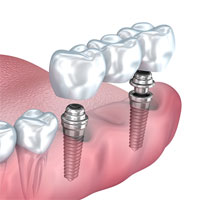
Restorative Care
Rebuilding Your Smile with Restorative Dentistry. When tooth structure is broken down due to disease, trauma, or poor bite, teeth can be permanently damaged or lost.
Restorative techniques utilize the strength of porcelain ceramics and precious metals such as gold and titanium to rebuild teeth to proper shape, size and function. Our goal is to return your smile to a comfortable, disease-free state that is easier to clean and maintain.
This approach also offers the opportunity to enhance smile appearance – we can make teeth appear whiter and sometimes make them look straighter or more evenly aligned by combining cosmetic dentistry techniques with the restorative process.
Replacement of Missing Teeth
In the natural development and aging process, the only teeth that are truly designed to be lost are deciduous teeth, or baby teeth. (The exception being “wisdom” teeth or third molars, which are typically recommended for extraction as they are nearly impossible to keep clean, making them prone to decay and infection).
If a permanent tooth is lost, the oral system malfunctions - in most cases, other teeth will shift into the space that is left open and drift into a spot that does not fit the bite properly. This misalignment causes teeth to come together abnormally, resulting in tooth trauma that can lead to teeth sensitivity, cracked teeth, nerve damage, and eventual loss of other teeth.
Dr. Rodriguez offers a full complement of Restorative Services, including:
A dental crown covers the top portion of a tooth that has been structurally compromised by decay, broken-down fillings, or trauma. A dental bridge is used to replace one or more missing teeth by anchoring at either side to existing healthy tooth structures or dental implants.
An all-porcelain crown or bridge restoration is bonded in place, without the need for metal substructures. No more unnatural-looking grey metal edges!
Learn more about All-Porcelain Crowns & Bridges »
Porcelain inlays and onlays cover more tooth structure than a dental filling, but unlike a dental crown, does not cover the entire top portion of the tooth. A dental inlay is similar to a filling, covering just the center groove portions of a tooth, whereas a dental onlay will cover more of the chewing surface of the tooth. This approach requires less removal of tooth structure and is more conservative than a full-coverage dental crown.
Porcelain materials are durable and appear more natural than metal restorations; however in some cases gold may be recommended.
Veneers are thin, custom-shaped facings that adhere to the fronts of teeth to cosmetically enhance their appearance. Porcelain dental veneers are ideal for teeth that are:
- Irregular in shape, size, or color
- Teeth with worn, uneven, or chipped edges
- Gapped or overlapping teeth
Your dental veneers are custom-designed for your smile and fabricated with durable esthetic porcelain. Veneers can transform a smile with minimal drilling or tooth preparation.
Learn more about Porcelain Dental Veneers »
Replace one or more missing teeth with dental implants.
Dr. Rodriguez works closely with local dental specialists to coordinate the placement of dental implants. These tiny titanium cylinders act as structural replacements for the roots of lost teeth to create a foundation that is restored with a dental crown, bridge, or implant-supported denture.
Learn more about Dental Implants »
Esthetic Complete & Partial Dentures
Dentures today can be designed to look natural and fit properly, so you can eat, smile and laugh with confidence. After consulting with you about your goals for your smile, Dr. Rodriguez partners with our local dental laboratories to design the shade, shape and size of each tooth, tissue height and color to achieve a completely comfortable, natural-looking denture.
Many denture patients that are fitted with custom esthetic dentures with implant supports find that they can eat foods they previously avoided with their old dentures, and are very comfortable laughing and smiling in social settings. It is a true joy for us to be a part of such an amazing transformation!
Did you know? Gold has been in use in dentistry since the time of the ancient Egyptians, and even today remains undisputed as the most long-lasting material for dental restorations.
The Advantages of Gold in Dentistry
Gold is highly pliable, making it an excellent material for shaping and rebuilding tooth structure. It is ‘biocompatible’, meaning it is safe and non-toxic; gum tissues do not become irritated with gold as they do with some restorative materials.
With inherent properties that allow it to expand and contract with thermal changes in the mouth, gold does not crack, chip or shrink as is possible with other dental materials. The strength of gold makes it ideal for repairing back teeth, and it can be used as a backing for porcelain restorations in front teeth for added reinforcement to sustain biting pressures.
Gold Inlay & Onlay Restorations
Dr. Rodriguez provides conservative gold restorations, such as inlays and onlays, wherever possible, as they require removal of less tooth structure than a crown. (Inlays fill small holes and onlays replace larger sections of the tooth.)
Gold is the optimal upgrade from a filling, many patients retain gold restorations for a lifetime. Because of their tolerance of temperature changes in the mouth, gold inlays and onlays are typically less sensitive than silver or tooth-colored fillings. If you have older fillings that need replacement, gold is a conservative option and a great health investment.
Protecting Your Smile against Tooth Decay
Molar (back) teeth have very deep grooves and pits in the chewing surface that are often impossible to clean with a toothbrush. These areas become a ‘safe harbor’ for harmful oral bacteria and can eventually develop into dental cavities.
As a preventive measure (especially for children), dental sealants are the first choice to help protect teeth against this destructive process. After a cavity develops, however, it becomes necessary to remove the decay and restore the tooth with a filling to prevent infection and pain.
Mercury-free “White” Fillings
Tooth-colored “white” fillings are made of composite resin material and are available in a number of natural-looking shades to match existing teeth. They are non-metallic and mercury-free, and many have fluoride-releasing properties.
Large areas of decay and broken tooth structure typically require more durable restorations such as conservative gold restorations or crowns. White composite fillings, however, can be a great solution for minor repairs.
Signs & Symptoms of Dental Decay include:
- Sensitivity to hot, cold or sweets
- Deep, dark stains in the tooth surface
- Areas between teeth that catch and snag dental floss
- ‘Holes’ in teeth
- Tooth pain, swelling and abscesses
Dental decay is progressive and unstoppable without treatment. The only way to arrest dental decay is by removing it and placing a restoration to prevent recurrence. If you have any of these symptoms, please contact us to address the problem as soon as possible.
Protecting Your Teeth and Your Budget
It is important to uncover small areas of decay as early as possible. Regular preventive care with necessary xrays is your family's best defense against dental decay.
Root Canals Save Teeth
Our goal is always to prevent dental decay and infection, and to save your teeth whenever possible. Restoring a tooth with root canal treatment and a dental crown can save the tooth from further damage or extraction. The tooth retains its position in the mouth, preserving healthy tissue and bone levels, and can help to prevent additional dental problems caused by surrounding teeth shifting into the space of the missing tooth.
Learn more about Root Canal Therapy »
Schedule a Restorative Consultation
If you are facing challenges with your smile, such as missing or broken-down teeth, you are not alone. Don't struggle with dental problems - together we can create a plan to save your teeth that fits your schedule and your budget. Contact us to schedule a complete examination and consultation.
